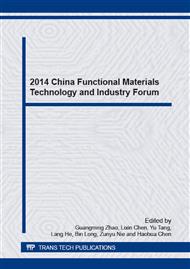[1]
X. Nie, E.I. Meletis, J.C. Jiang, A. Leyland, A.L. Yerokhin and A. Matthews: Surf. Coat. Technol., Vol. 149 (2002), p.245.
Google Scholar
[2]
P.B. Srinivasan, C. Blawert and W. Dietzel: Mater. Sci. Eng. A, Vol. 494 (2008), p.401.
Google Scholar
[3]
W.B. Xue, Q. Jin, Q.Z. Zhu, M. Hua and Y.Y. Ma: J. Alloy Compd., Vol. 482 (2009), p.208.
Google Scholar
[4]
X.H. Wu, W. Qin, Y. Guo and Z.Y. Xie: Appl. Surf. Sci., Vol. 254 (2008), p.6395.
Google Scholar
[5]
J.M. Lee, S.B. Kang and J.M. Han: Wear, Vol. 264 (2008), p.75.
Google Scholar
[6]
C.E. Barchiche, E. Rocca, C. Juers, J. Hazan and J. Steinmetz: Electrochim. Acta, Vol. 53 (2007), p.417.
DOI: 10.1016/j.electacta.2007.04.030
Google Scholar
[7]
F. Chen, H. Zhou, B. Yao, Z. Qin and Q.F. Zhang: Surf. Coat. Technol., Vol. 201 (2007), p.4905.
Google Scholar
[8]
D.Q. Wei, Y. Zhou, Y.M. Wang and D.C. Jia: Appl. Surf. Sci., Vol. 253 (2007), p.5045.
Google Scholar
[9]
G.H. Lv, H. Chen, W.C. Gu, L. Li, E.W. Niu, X.H. Zhang and S.Z. Yang: J. Mater. Process. Technol., Vol. 208 (2008), p.9.
Google Scholar
[10]
P.B. Su, X.H. Wu, Y. Guo and Z.H. Jiang: J. Alloy Compd., Vol. 475 (2009), p.773.
Google Scholar
[11]
C.B. Wei, X.B. Tian, S.Q. Yang, X.B. Wang, R.K.Y. Fu and P.K. Chu: Surf. Coat. Technol., Vol. 201 (2007), p.5021.
Google Scholar
[12]
H.P. Duan, C.W. Yan and F.H. Wang: Electrochim. Acta, Vol. 52 (2007), p.3785.
Google Scholar
[13]
A.L. Yerokhin, X. Nie, A. Leyland, A. Matthews and S.J. Dowey: Surf. Coat. Technol., Vol. 122 (1999), p.73.
Google Scholar
[14]
X.T. Sun, Z.H. Jiang, S.G. Xin and Z.P. Yao: Thin Solid Films, Vol. 471 (2005), p.194.
Google Scholar
[15]
W.C. Gu, G.H. Lv, H. Chen, G.L. Chen, W.R. Feng, G.L. Zhang and S.Z. Yang: J. Mater. Process. Technol., Vol. 182 (2007), p.28.
Google Scholar
[16]
J. Liang, L.T. Hu and J.C. Hao: Appl. Surf. Sci., Vol. 253 (2007), p.4490.
Google Scholar
[17]
Y.M. Wang, T.Q. Lei, B.L. Jiang and L.X. Guo: Appl. Surf. Sci., Vol. 233 (2004), p.258.
Google Scholar
[18]
J. Liang, P.B. Srinivasan, C. Blawert, M. Störmer and W. Dietzel, Electrochim. Acta, Vol. 54 (2009), p.3842.
Google Scholar
[19]
L.M. Chang: J. Alloy Compd., Vol. 468 (2009), p.462.
Google Scholar
[20]
S. Moon and Y. Jeong: Corros. Sci., Vol. 51 (2009), p.1506.
Google Scholar
[21]
K. Tillous, T. Toll-Duchanoy, E. Bauer-Grosse, L. Hericher and G. Geandier: Surf. Coat. Technol., Vol. 203 (2009), p.2969.
DOI: 10.1016/j.surfcoat.2009.03.021
Google Scholar
[22]
W. Zhang, K.Q. Du, C.W. Yan and F.H. Wang: Appl. Surf. Sci., Vol. 254 (2008), p.5216.
Google Scholar
[23]
L. Wang, X.Z. Jiang and Y.J. Liu: J. Hazard. Mater., Vol. 154 (2008), p.1106.
Google Scholar


